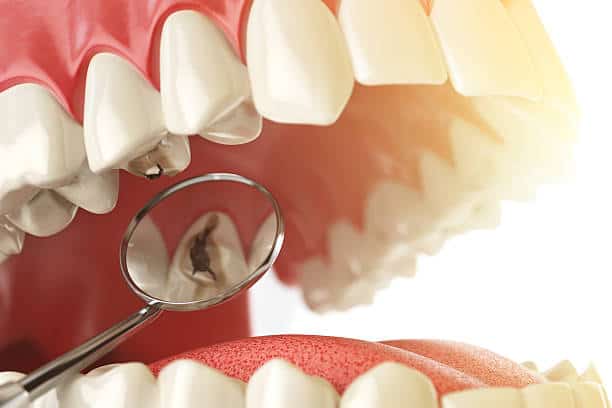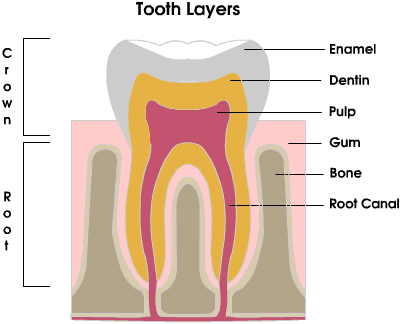What are Cavities and How to Prevent Them

For this week’s blog, Dr. Dhaliwal is taking it back to the fundamentals. She’s answering the basic question of what are cavities and how can we prevent them.
What is a Cavity?
Found in everyone’s mouth there can be millions to billions of bacteria with 10,000 to 100 million living on just one tooth alone! Certain types of these bacteria love to feed off sugars you eat, they then convert those sugars to acid. The acid softens the enamel and can eventually cause the tooth to decay and become a pit or hole, this is when we use the term a cavity. When the decay reaches the second layer of the tooth, the dentin, that is when it needs to be repaired.
Are There Any Early Signs of a Cavity?
Yes! Sometimes, but not always, you can tell a cavity is starting. Here are some signs and symptoms to be on the watch out for:
- Sensitivity to cold, hot or sweet foods and drinks
- Sensitivity to flossing or brushing
- Visible holes or pits in your teeth
- Change in the appearance of your tooth from a normal color to chalky white to brown or black
Can Cavities Heal Themselves?
To put it simply, yes and no.
Yes if…
The cavity is still in the enamel layer, the outer most layer of your tooth. Use floss and blast the demineralized area with fluoride to stop the spread of the cavity. Use fluoridated toothpastes, fluoridated mouth rinses and avoid sugary, acidic foods and drinks to help slow or stop the progression of the bacteria.
No if…
The cavity has reached the dentin layer of the tooth, the second layer of the tooth. The dentin layer is much softer than the enamel and also has small tubes that cause the cavity to grow much faster than if it was in the enamel alone. Once it reaches the dentin there is no stopping it without intervention by a dentist.

What Happens if I Leave the Cavity Alone?
The bacteria in your mouth love being nestled in your tooth. They feed off sugars, reproduce and burrow deeper into the tooth if untouched. Eventually, the bacteria reach the last layer of the tooth, the pulp. The pulp layer has the nerves of the tooth resting in it, so when the bacteria reaches it, that is typically when you will experience pain. At this point, a simple filling won’t be enough to remove the cavity since the bacteria is now living in the pulp’s canals.
To remove bacteria in the pulp, the pulp is removed by either having a root canal performed or having the entire tooth extracted from your mouth. If the bacteria still isn’t removed after it has reached the pulp it will keep spreading down the root’s canals until it reaches the bone. This can become extremely dangerous. Eventually, the bacteria can cause extreme pain, swelling and even become life-threatening. The bacteria can travel into the bloodstream or other important regions in your body.
How Can I Prevent a Cavity?
- Decreasing Sugar and Acid in your Diet: Remember we told you that the bacteria in your mouth feed off sugar? Decreasing sugary drinks and foods give the bacteria in your mouth less energy to feed off of and therefore decreases the acid produced. Also, bacteria love acidic environments, hello they produce it! So by decreasing the consumption of acidic foods and drinks, such as citrus, red wine, and sodas, it will make a more hostile environment for the bacteria. This also helps prevents the enamel of the tooth from softening as well. Check out our blog about healthy foods to get an idea of some substitutions to replace your sweet cravings.
- Disturbing Where the Bacteria Grows: Earlier we discussed how the bacteria rests on your teeth. When you brush and floss you disturb the bacteria and force them out of their comfy home. Brushing and flossing also help to remove food debris which decreases their snack time! The more you brush and floss, the more you disturb the bacteria, the less of a chance the bacteria has to rest on your tooth!
- Introducing Fluoride to Your Diet: Introducing fluoride into your diet can decrease the chances of getting a cavity. Fluoride is a mineral that helps strengthen your tooth. By using fluoridated toothpaste and mouth rinses you can strengthen your tooth, making it harder for the acid to penetrate your tooth and soften it.
- Sealants: Our back permanent molars can often have very tiny grooves and pits, which can be near to impossible for a toothbrush to reach. Flowing a material onto these teeth can seal off the grooves and cracks, preventing bacteria and food from entering. Sealing off these teeth will also make it easier for you to brush back there.
- Changing Out Your Toothbrush: Making sure your toothbrush isn’t worn out will help when disturbing the bacteria in your mouth. A good rule of thumb is every three months or if you see any splaying with the bristles. If you really want to give those bacteria the boot, Dr. D recommends an electric toothbrush. But make sure the electric toothbrush has a sensor to tell you if you’re brushing too hard so you don’t damage your teeth and gums!
Remember to visit us twice a year so we can spot those cavities early on and prevent them from growing. Follow these tips and make your visits with Dr. D a breeze!



